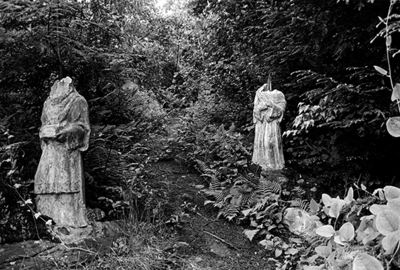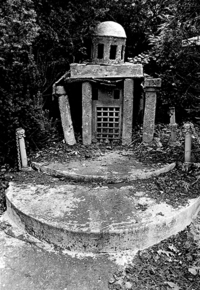Reading the Ruins
Holy Land: Photographs by Joy Bush
Through September 8, 2013
Mattatuck Museum
Waterbury, CT
203-753-0381
www.mattatuckmuseum.org
—
by Stephen Vincent Kobasa

Joy Bush, Holy, 1997. Image courtesy of the artist.
A Holy Land laid waste seems closer to the truth somehow, if one thinks only of the present day in which the square outside the Church of the Nativity in Bethlehem has been filled with tear gas, and a thirty-foot wall marks the western border of Jerusalem. But the inaccurate model of that landscape spread across nearly twenty acres of a hillside in Waterbury, CT, was not intended—by John Greco, a Waterbury attorney who began its construction in 1955—to be a lesson in current events. Neither did he imagine it becoming a long, continuing history of decay after its closing thirty years ago.

Joy Bush, Pyramid, 2000. Image courtesy of the artist.
Since 1987, in a series of black-and-white images that strip this curious place to its essentials, Joy Bush has been compiling a meditation on the ruins of belief. To the particular melancholy of an abandoned amusement park she has brought the grieving clarity of a war photographer. Her work identifies these manufactured relics as examples of a sentimental history like those 18th-century English garden monuments built to look as if they had crumbled in place. Yet here, this claiming of a past that does not belong, later to assume more spectacular scale with the Las Vegas Sphinx, is given a specifically American mix of kitsch and desperation. Imagine it as “a city upon a hill,” that self-confident Puritan vision of grandeur rendered in traditional Roman Catholic iconography, then revealed as a sham.

Joy Bush, Magi, 2000. Image courtesy of the artist.
What Bush identifies so well is the way in which the surviving wreckage of the place makes sense; she captures an unconscious intention that all this might well have been meant for a ruin, its power magnified by slow vanishing. The giant overgrown and graffitied metal letters that identify the site are evocative of the Hollywood sign that was originally followed by the word “Land.” This places it in the tradition of cinematic pageants like those of Cecil B. DeMille who was directing his film The Ten Commandments at the same time that Holy Land USA was being built. Even if on a somewhat smaller scale, the details of this Waterbury landmark were nearly as ornate and exaggerated, and as fragile, as those sound stage sets. The crudeness of their construction is still somehow convincing, where the cell in the photograph entitled Summer brings the imagination immediately to the sounds of torture. In Abandoned the sheet metal and wood appear as if they had been crushed by some weight, the past crumpling the landscape like a deformed memory. Then there is a procession of decapitated concrete magi, leaving open the question of the difference between vandalism and collecting. Temple has an eerie resemblance to the skeleton dome left after the Hiroshima bombing, and, in Tower, one of the most telling images Bush composes, a single piece of toy architecture balances on a rock slope in front of a giant cross, beneath clouds that appear to be more permanent than the landscape below.

Joy Bush, Temple, 2000. Image courtesy of the artist.
There has been a recent campaign to purchase the property that the remains of Greco’s project still stand on, but to what end? How would one reinvent, much less restore, such a place? These photographs make a different argument. One of them shows metropolitan Waterbury, all its industrial fabric now wiped away, from the vantage point of Holy Land—one ruined city overlooking another. This is the way it should be left, like a prophecy of the disaster that has found us.
